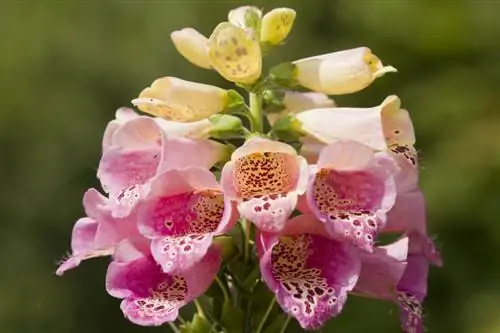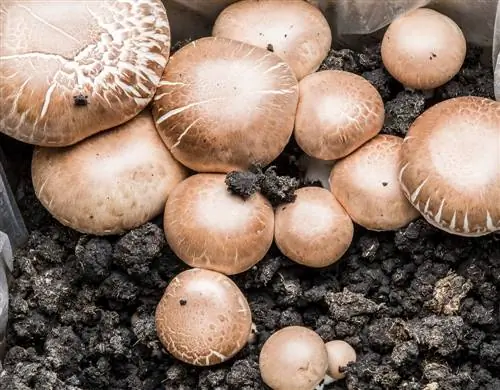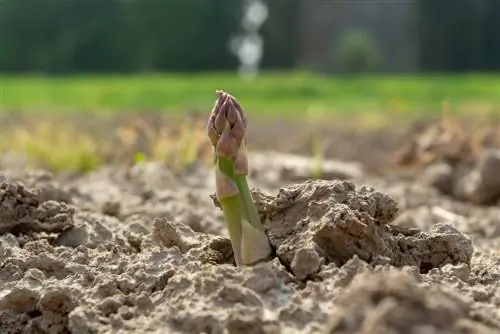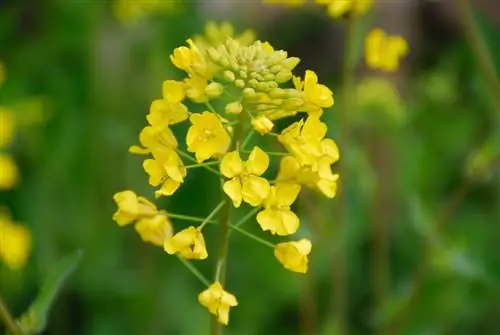- Author admin [email protected].
- Public 2023-12-25 17:45.
- Last modified 2025-06-01 06:02.
Elegant structure builder, poisonous beauty, undemanding, continuous bloomer - the list of its attributes is long. The foxglove has long been more than just the typical plant for the cottage garden in creative garden design. The following lines reveal how the virtuoso flower thrives in your green kingdom.

How to care for foxgloves in the garden and make them bloom?
A foxglove thrives best in a sunny to partially shaded location, in nutrient-rich, permeable and fresh, moist garden soil with a normal clay content. Regular watering and the supply of complete mineral-organic fertilizer or compost support magnificent flowering from June to August.
Planting foxgloves correctly
To plant the foxglove in the garden, you have the choice between sowing in the summer and planting a ready-made flower. If you decide to purchase young plants from the garden center, you won't have to wait until next year for the first flowering. This is how the flower grows quickly:
- The planting season begins in May, right after the Ice Saints
- Dig a planting hole in a suitable location with twice the volume of the root ball
- Mix the excavated material with compost or ericaceous soil and fill it in again
- Plant the young flower in the middle just as deep as before and water it
The natural beauty of foxgloves is particularly effective in small groups of 3-4 specimens. A planting distance of 40 centimeters is considered appropriate.read more
Care tips
As long as a foxglove doesn't have to thirst or go hungry, it shows itself from its most beautiful side. Therefore, water the plant regularly and thoroughly with collected rainwater or decalcified tap water. You should avoid targeted bombardment of ice-cold water from the garden hose on this flower.
The need for nutrients is covered by a mineral-organic complete fertilizer in March/April. In natural gardens, mature compost is used as organic fertilizer every 14 days from May onwards, ideally supplemented with horn shavings.
Which location is suitable?
Foxglove prefers a sunny to partially shaded location. The tightly upright flower feels extremely comfortable in the protection of tall trees, where it acts as a magnificent backdrop plant. The foxglove avoids limestone soil. Instead, the plant thrives vitally and he althily in nutrient-rich, permeable and fresh, moist garden soil with a normal clay content.read more
When is flowering time?
The flowering period of foxglove begins in June/July and lasts until August. In summer weather there is a chance of re-blooming if you cut the flower back after the first bloom.read more
Cut the thimble correctly
There are several arguments in favor of cutting back the foxglove. First and foremost, you will encourage repeat blooms if the flower is cut after the first bloom. In addition, you prevent self-seeding, which is not always desirable. Don't forget the vase cut so that the lush flower stalks decorate the house.read more
Wintering
All native foxglove species are completely hardy. Even frosty temperatures of -20 degrees Celsius do not cause any problems for this plant as long as it is cultivated in a bed. In the pot, however, there is a risk that the root ball will freeze due to its exposed position. Therefore, these precautions are recommended:
- Cut the plant close to the ground in autumn
- Cover the substrate with bark mulch, straw, sawdust or leaves
- Cover the planter with several layers of jute, fleece or bubble wrap
Place the bucket on an insulating surface, such as wood or Styrofoam, so that the frost does not damage the root ball from below.read more
Propagate foxgloves
Foxglove is easy to propagate by sowing. If you do not cut the flower back after it has bloomed, numerous capsule fruits will develop. The tiny seeds are inside. If you want the plant to remain in its location, simply let nature take its course. The flower distributes the seeds independently.
If you would like targeted propagation at the new location, the specialist retailer has pure seeds (€2.00 on Amazon) available for you. Sowing can be done behind glass from March/April or directly in the bed from July/August. The seeds are light germinators that do not have to undergo any stratification.read more
Is foxglove poisonous?
It was no coincidence that the foxglove received the title “Poisonous Plant of the Year” in 2007. Due to its high content of digitalis glycosides, the flower is one of the ultimate poisonous plants in the forest and garden. The toxin is mainly present in the leaves. The lushly flowering plant poses a life-threatening danger, especially to children. They play with their thimbles, put their fingers in their mouths and suffer poisoning with these symptoms:
- Nausea and vomiting for many days
- As the progression progresses, vision problems
- The pulse rate drops steadily to 50, in the worst case to 20 beats per minute
- A dose of 2.5 grams or more is considered fatal for children
Regardless of its lavish abundance of flowers, cultivation in the garden should be avoided if children and pets are present.read more
Is foxglove poisonous to dogs?
Foxglove's extreme toxicity doesn't just apply to humans. If a dog chews on more than 5 grams of this plant, there is no salvation. Smaller amounts of foxglove cause classic symptoms of poisoning, such as staggering, vomiting and bloody diarrhea. Dog lovers therefore banish this poisonous plant from the garden for the sake of their four-legged companions.read more
What you need to know about foxglove seeds
The seeds are of fundamental importance for the survival of the two-year-old plant. In August they ripen in the brown capsule fruits. A typical foxglove seed is 0.5 cm small, elongated in shape, brownish in color and either ribbed or flattened. To get it in the mood to germinate, it must not be covered with substrate. All seeds of this flower are light germinators.read more
Sowing foxgloves
The ideal time for sowing foxglove is in July/August, when the plant also sows itself. Alternatively, spring can be considered, then behind glass or in a cold frame. Direct sowing has not proven successful in practice. The very fine seeds germinate much better under controlled conditions. Mix the seeds with a little bird sand and press them into sterile sowing soil. The light germs are moistened with lime-free water from the atomizer.
In a partially shaded, warm location, the cotyledons break through the seed coat within a few days. The seedlings are pricked out when the first real leaves appear. Once a strong plant has developed, it goes to its final location to bloom the next year.read more
The leaves of the foxglove
It is the leaves that contain the highest levels of poison on the foxglove. The danger potential is at its highest when the biennial plant only develops a rosette of leaves in the year it is sown. The leaves are then mistaken for weeds, so that the toxin accidentally gets into the mouth via the hands. You can identify the highly toxic foxglove leaves by these attributes:
- Basal leaves are stalked and up to 20 centimeters long
- Spiral or alternating arrangement
- Leaf edges smooth, notched or sawn
- Lancelloid or oval shaped
- Grey-white hair on the bottom or both sides
read more
Is foxglove perennial?
The fact that foxglove thrives as a biennial plant always raises eyebrows among hobby gardeners. The reason for the confusion is that the plant only forms a rosette of leaves in the first year and only flowers in the second year. Depending on the species, the flower dies before winter or appears again next year in a lavish display of colors, only to finally die.read more
Is foxglove hardy?
All native foxglove species are completely hardy. In the bed they survive the cold season without any special precautions. If the withered parts of the plant affect the visual appearance in autumn, simply cut the plant back to the ground. With a little luck, the flower will appear again next year, regardless of its classification as a biennial plant.
In the pot, however, the foxglove is more vulnerable to the rigors of winter. Here the root ball is in danger of freezing. Therefore, cut back the flower in autumn and cover the substrate with leaves, straw, sawdust or needle twigs. The planter receives a winter coat made of jute or bubble wrap.read more
Foxglove under nature protection
The foxglove is one of the plants that are protected. This means that you are not allowed to pick or dig up the flower in the wild. That's a good thing, considering the high poison content.read more
The foxglove species
Of the 25 foxglove species, these 3 magnificent specimens are native to us:
- Red foxglove (Digitalis purpurea), equipped with special adaptability for sunny, semi-shady and shady locations
- Yellow foxglove (Digitalis lutea), delicate in growth and more lime-tolerant than its counterparts
- Large-flowered foxglove (Digitalis grandiflora), the plant with the largest flowers, reaching a length of 5 centimeters
In addition, the rust-colored foxglove (Digitalis ferruginea) has established itself in Germany in mild winter locations.read more
An overview of the most beautiful varieties
The foxglove plant genus includes a total of 25 species, of which only 4 thrive in the local regions. The following varieties therefore come from either the large-flowered foxglove (Digitalis grandiflora), the yellow foxglove (Digitalis lutea), the red foxglove (Digitalis purpurea) or the rust-colored foxglove (Digitalis ferruginea).
- Apricot: an adaptable variety with impressive, yellowish-pink flowers
- Candy Mountain: a majestic flower with red flowers and a height of 150-180 cm
- Alba: the white flowering plant stretches 150 cm towards the sky
- Pam’s choice: the magnificent Digitalis purpurea presents white flowers with purple spots in the throat
- Large-flowered yellow foxglove: the yellow-flowering plant impresses with bell flowers up to 5 centimeters long
- Gloxiniaeflora: this flower enchants with red dotted, extra large flowers in delicate pink and bright pink
- Snow Thimble: the white flowering plant exudes the unique elegance of a foxglove
- Primerose Carousel: the yellow flower is recommended for pot cultivation thanks to a height of only 75 cm






